Autism is a set of disorders that affect communication, sensorimotor and social integration, thus it leads the autistic individual to have repetitive movements, restricted interests and in addition deviations in language. Studies and research have found that education and remediation for autism can be innovative and personalized. Since then a call for learning through games has arisen. Our article is a major compliment to an electronic serious game: JESTIMULE dedicated to teaching autistic children emotional facial expressions, and as it is in use we value the idea of sharing our special technique of collecting results after the passing of the sessions.1
Keywords: Serious games, JESTIMULE, Autism, Learning
Autism, which is already the subject of debate; encounters another kind of concern: learning disabilities and the care of autistic children. Ideas and initiatives have always ignited the journey of understanding autistic disorder and also presented remedies in the form of changing habits, behavior and knowledge. Serious games have a 'serious' positive impact in the course of remediation in autism spectrum disorders. JESTIMULE is one of those video game programs that are aimed at children with autism in order to make them learn the recognition of emotional facial expressions, then what the understanding of the emotions of others promotes social integration.
The development of JESTIMULE presented a method for collecting results, but it remains to understand it and present it easily to readers. This paper offers our facilitated method of collecting results after using JESTIMULE in order to share and help researchers to effectively communicate their work of the same kind.
One of the most characteristic disorders that can stigmatize an autistic person is the disturbance of his cognitive functioning, which ceases to be normal in quality and in the resulting reactions. Who says abnormal does not mean incomprehensible or out of all human aspect. So how to explain?
The cognitive functions affected in autism are: processing of information, integration of information, intellectual level, language. Intellectual disability is frequently associated with autism. 75% of children with autism have a deficiency and the majority of intelligence quotients are between 35 and 50. The concept of intellectual deficit must therefore be taken into account because this problem affects a majority of people affected by autism.1
In addition, autistic people with a good intellectual level access memorization strategies involving the semantic and syntactic aspects of language. This data comes to contradict the first works of Hermelin and O'Connor which related to the memorization and the recall according to the type of material.2
The function of information processing is altered, but the fact of knowing the level of manifestation of this alteration or its nature, is still ambiguous. The hypotheses put forward do not make it possible to account for the behavior encountered in autistic people with better intellectual abilities. Moreover, the problem of the disturbance of responses to stimuli does not really arise in terms of sensory deficit as such. Hypotheses addressing higher levels of information processing and integration seem more relevant.1
Children's ability to get along with other people and see things from their perspective is a matter of social cognition. The basis of this crucial ability rests on the development of theory of mind. This theory relates to our understanding of people as mind-functioning beings, each with their own mental states – such as their thoughts, desires, reasons and feelings. We use theory of mind to explain our own behavior to others, telling them what we think and want. We also interpret people's words and behavior by imputing thoughts and intentions to them. The development of theory of mind in young children.3
Another approach to the problem of information processing in autism locates the difficulty at the level of regulation and executive functions. Dysfunctions at the level of executive functions would underlie certain anomalies of information processing and therefore of social and non-social behavior. The executive functions cover a set of abilities depending on higher functions which make it possible to control the action, and especially the adaptation of the action in a new context and therefore flexibility. Planning and controlling behavior, changing behavior, inhibiting automatic actions, and retaining information in working memory during task execution are part of the executive functions. Abnormalities of these executive functions reflect dysfunctions of the frontal system and can explain, for example, repetitive behaviors.1
Language problems in people with autism range from failure to develop functional language (50% of people remain non-verbal) to developing functional language but idiosyncratic usage. Language sometimes appears at the end of the first year and then disappears. In this case, speaking may or may not reappear in later development.
The precocity of the installation of a language is a favorable factor because the children who present elements of language at two years have a better prognosis than the others.4 Even if language anomalies are truly at the heart of autistic disorders, the communication problem is more global because all its aspects, whether verbal or non-verbal, are affected.
Psychobiological states of an emotional nature are essential prerequisites for the formation of structured and adapted social bonds.5
Innovation in education and training is a relatively recent subject of reflection. It has only interested social science researchers since 19606 and often in operational terms. Indeed, the texts relating to innovation are, for the most part, writings narrating an innovation as an action or focusing on the new product.7 Few theories or even theorizations of innovation exist as such.
If research on innovation is recent, the term is old and has been used since the 13th century. We find it more frequently in the 18th century in a particular sense: “Innovation: introduction of some novelty into a custom, into a use, into an act, no innovation should be made. Innovations are dangerous.
In other words, innovation was considered until recently as something harmful to the evolution of society. Innovation was synonymous with danger for the balance of the institutions which had to remain as they were. Innovation engendered imbalance, disorder; it was potentially generating the disintegration of civil society. It had the meaning that we now give to subversion or revolution. Behind this, there was the conception of a transgression of the divine will and innovation was seen as the pernicious fruit of human freedom.
It was not until the 20th century and, more specifically, the 1960s, that the word innovation appeared in France, with a positive, even injunctive, connotation. Currently, innovation is needed in all areas.7
A Serious Game is a video game that conveys a serious, educational, social, charitable, advertising, journalistic message... It is a computer application combining a serious objective with playful elements.
The Serious Game has a utilitarian purpose allowing the user to improve his skills by training, to become accustomed to situations to treat his phobias, or to understand a situation to receive an education.
The most synthetic definition of a Serious Game is that proposed by video game designers Michael and Chen8: “Any game whose primary purpose is other than simple entertainment”. According to this definition, a Serious Game potentially applies to a multiplicity of sectors: education, health, advertising, communication, politics, humanitarian, defence, religion, art... In the context of this article, we are only interested in games used in education. According to this simple definition, a Serious Games can be a game on any type of medium. The first examples of Serious Games known for the education sector, which date back to the 1960s and 1970s, were moreover mainly card, board or role-playing games.9,10 If this idea of using the game as a teaching aid has remained more or less popular over time, it experienced a sharp decline at the end of the 1990s, in particular with the fall of the current of so-called "ludo-educational" games.11 In the first half of the 2000s, a new trend therefore sought to relaunch this concept, under the name Serious Game, this time refocusing almost exclusively on video games.12
Through this new wave of Serious Games, we now have an ever-increasing number of video games that openly claim an educational interest.
The advantages and limits of the Serious Game for education vary significantly depending on the game chosen and its context of use, so there is no simple or absolute answer to this question. However, many case studies have been conducted by researchers in the field. In their review of the literature on the issue, Pivec and Pivec13 point out the following main advantages:
- a. Learner motivation
- b. Learning by trial and error
- c. Taking into account differences in learning rhythms
- d. The stimulation of pedagogical interactions between pupils.
JESTIMULE (Educational Game for the Multisensory Stimulation of Children with Pervasive Developmental Disorders) is a serious game for educational and therapeutic purposes. A multi-sensory tool combining visual, auditory and tactile feedback, it is used in addition to the psychotherapy of children with pervasive developmental disorders, in particular autistic disorders, with the aim of re-educating social codes.
Children will have to learn to recognize and anticipate emotions through two phases:
Learning: the child must learn to recognize emotions thanks to a color code and tactile patterns sent by the controller. Composed of 26 mini-games, its objective is to learn the emotions on the faces of characters and the associated emotional gestures.
Seven emotional expressions, a facial expression (grimace) and a color symbolizing the absence of emotion are presented in the game. The division into different levels is carried out in such a way as to be adapted to the player's profile: the accompanying person chooses according to the player and the level it launches. The use of the color code makes it possible to offer a mode of response to children who are not readers as well as to child readers.
Experimentation: The child must recognize and anticipate emotions in context. The idea is that he can, through the situations he encounters, index a context and deduce the corresponding emotions. Each correct answer will allow him to win a piece of the puzzle. It puts emotions into context in social situations. The player uses the context in order to recognize and anticipate the different emotions of the characters, to initiate appropriate requests and to make choices of action following the presentation of communication gestures. This phase also aims to assess the emotional expressiveness of the avatar of the child with Autism, focusing on the expression of his own emotional feelings.
In order to work on generalization, 3 modules are offered in this phase. The social situations presented are the same, but their location or the characters they contain are different.
The subjects:
Two autistic children were the subject of the study:
The first is a 16-year-old child, integrated since 2011, i.e., 4 years of care by the association, his language is cut up but remains correct, adaptable, the most observable signs of autism in him are: echolalia at low voice, vocal and motor excitement once the routine is disturbed. Outside these conditions, he is calm, his gaze is directed towards his interlocutor but the pointing is practiced if requested by a companion. Before his integration into the association, he was very clumsy, not autonomous, and severe self- mutilation seemed so a strange person directed him to speak. The difficult childbirth with lack of oxygen and general weakness marked his first days, as an infant he often had nervous crises. The second, is a 12-year-old, non-verbal, skinny, he is autonomous, his gaze is directed towards the people who are talking to him, but he does not maintain it for long, the pointing is totally absent. Its development during the first two years was normal, it is then altered by an attack of intense crying with increased temperature, the diagnosis took years to give the answer: chronic otitis. The child is cured but the signs of autism are already installed. Two normal children aged 11 and 13 are the witnesses of the study.
JESTIMULE must be accompanied by what?
JESTIMULE is a dedicated program for autistic children, suffering from a deficiency of social contacts including the recognition of EFEs, so the researcher must present reliable and valid tools which ensure the installation of a state of autism in children. subjects, and which measure the disorder in the recognition of EFEs, while the intellectual level of each subject to eliminate the hypothesis of mental retardation.
Tool Suggestions:
- To assess the presence of an autistic disorder.
- LA cars – childhood autism rating scale
- ADI-R – autism diagnostic interview-revised
- L'ADOS-G – autism diagnostic observation schedule
- LE BOS – behavior observation scale
- The autistic behavior assessment scale – ECA
- Infant autistic behavior assessment scale – ECA-N
- Rimland questionnaire
- To assess the intellectual level.
- The Griffiths scale is a development scale applicable from 0 to 8 years.
- Kaufman's K-ABC is a test battery that is calibrated from 2.5 years to 12 years.
- The Wechler WISC-III is a classic test battery, calibrated for children up to 15 years old. There is a version intended for preschoolers (WPPSI).
- Progressive RAVEN matrices.
- To assess social and emotional skills.
- The Vineland (Vineland Adaptive Behavior Scale) (Sparrow et al., 1984 a and b).
- After the age of 12, the AAPEP (Adolescents and Adults Psycho-Educational Profile) is used. It assesses functional skills in the areas of imitation, perception, fine motor skills, gross motor skills, hand-eye integration, cognitive performance, language.
- Test sides.
- Evaluation grid.
Use JESTIMULE:
- For the researcher or the bettor
After receiving, the serious game JESTIMULE must be installed on a computer with a DVD player and a power that exceeds the threshold requested to start playing and follow the instructions. Whatever the user's information on this serious game, he must first create an account for him and play through all the stages very carefully, because the color codes and the avatars as well as the stages are numerous and they must be well learned by the person who is going to run the game.
- For the autistic subject (verbal and non-verbal)
Games of any kind are more enjoyable for children with autism; who are bored and who cannot concentrate; than an ordinary learning session.
To assemble the results of the two phases with their options and games, we aimed to find a more representative form and at the same time understandable and global, the result of our attempts will be presented below in the form of a table-grid extended on the number of games started in each option:
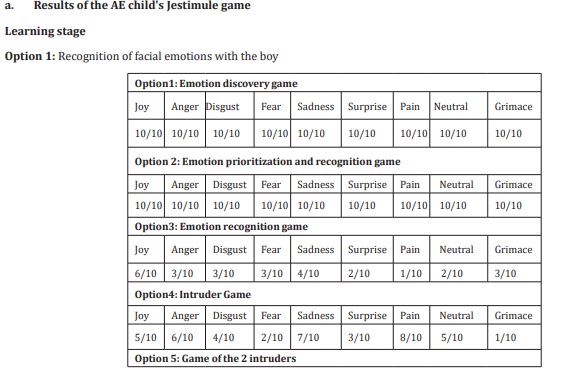

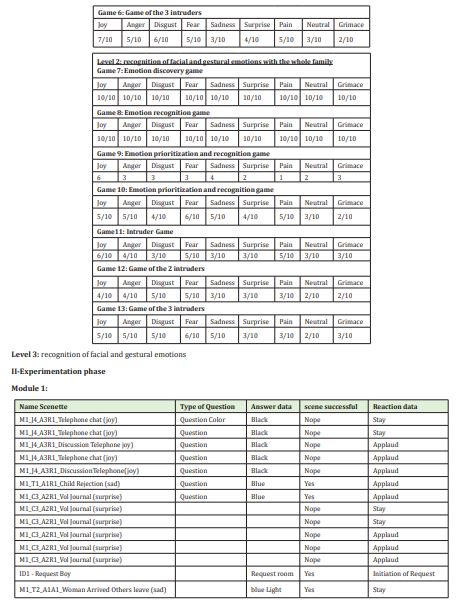
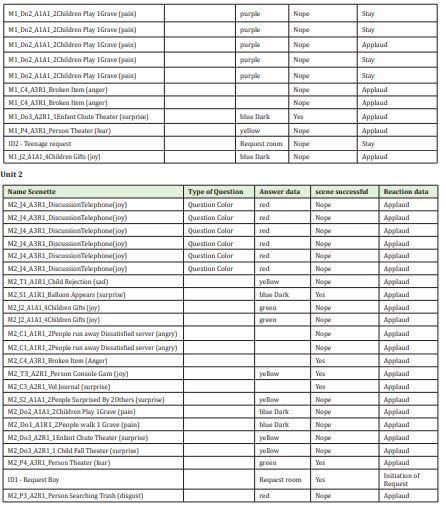



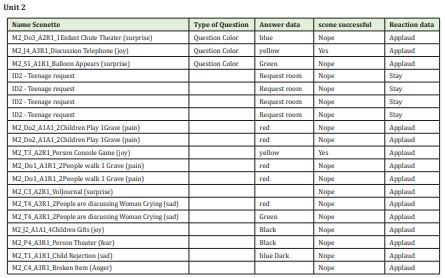
For the control subjects, the results were more correct and they found the game easier after learning the color codes and facial expressions that suited them.
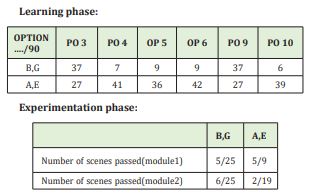
To summarize these tables-grids to present them in a scientific article or a presentation in a communication, they have been reduced as follows (in the reduction the results of the control subjects appear):
Considering the number of options and games organized in the serious game JESTIMULE, the results cannot be found in shorter details than this kind of representations, it is the basis for collecting the results in this case, well detailed and structured and easy.
The software is already clear and its steps are harmonious, because encountering obstacles could, without great consequence, become navigation-browsing.14 Concretely, an interface (material connecting two systems of different nature) can be defined as anything that helps humans understand and manipulate the machine; the central point of exchanges between the person and the machine; a layer made up of a hardware part (screen, keyboard, mouse, etc.) and a software part which interposes itself between the concepts of the machine and the user” (ibid.)15 Educational Games and Simulations: Studies by Cases and Lessons Learned 2/19/18https://books.google.co.ma/books?isbn=2760524183 Louise Sauvé, 0202 - vamf av diva sf av maavi avidE -. Indeed, a clear and readable interface is an essential element for any digital product, in particular for a product intended for a child-learner educational software The underestimated impact of the interface in the course Educational Softwares. Underestimated Impact of the interface in the Run Catherine Kellner16 http://journals.openedition.org 2/18/18
So clear and readable are the most admissible characteristics in educational software, including serious games, followed by a technical way of collecting results, which democratizes and generalizes it, especially with very specific educational software designating a restricted part of the population targeting a specific need among their multiple and interfering needs. Returning to Louise Sauvé and David Kaufman in their work (Educational software The underestimated impact of the interface in the course) who say that a "digital interface" is only effective if it meets two quality criteria: useful, i.e. adapted to the needs and expectations of users, and usable i.e. easy to learn and use, but they overlook a good quality that is to be assessable that is to say that it leads to the goal of learning through good results which must have the quality of readability and comprehensibility, and on the other hand they must have good educational quality as Olivier Hu in 2001 quoted: The relative failure of "cd-roms" today can largely be attributed to their low quality in front of a very demanding public, and which has every reason to be in front of their potential untapped.17 Design flaws, poor content, ineffective interfaces, misuse of multimedia, unsuitable teaching strategies, are all examples of common errors Contribution to the evaluation of educational multimedia software by Olivier Hu theses.fr http://www.theses.fr 2/22/18.
Although the efforts that are made to succeed in understanding and presenting the results of some educational software are a basic technique among science researchers, it remains favorable if the next innovations in this field of computer engineering, will contain an operation of collection of easy and representative results, like the one that distinguishes statistical software like SPSS and STATISTICA.
None.
None.
The authors declare no conflicts of interest regarding the publication of this paper.
- 1. Rogé B. Autism, understanding and acting. Dunod. 2003.
- 2. Hermelin B, O'Connor N. Psychological Experiments with Autistic Children. Pergamon Press, Oxford, UK; 1970.
- 3. Wilde Astington J, Margaret J, Edward MA. The Development of Theory of Mind in Early Childhood. Encyclopedia on early childhood Development. 2010.
- 4. Rogers SJ, Di Lalla DL. Age of symptom onset in young children with pervasive developmental disorders. Journal of the American Academy of Child & Adolescent Psychiatry. 1990;29(6):863–872.
- 5. Louis F, Wallon H. The origins of character in children. In: Neoscholastic Journal of Philosophy. 1934;p.42.
- 6. Fullan M. Staff development, innovation, and institutional development. In Changing school culture through staff development: The 1990 ASCD yearbook. Alexandria, VA: ASCD. 1990;pp.3–25.
- 7. Cros E. Formation of the cocoa aroma. CIRAD. Revue française de pédagogie. 1997;118(1):127–156.
- 8. Chen X, Carroll CD. First-Generation Students in Postsecondary Education: A Look at Their College Transcripts. Postsecondary Education Descriptive Analysis Report. NCES 2005-171. National Center for Education Statistics. 2005.
- 9. Abt HA. Catalog of Individual Radial Velocities, 0h-12h, Measured by Astronomers of the Mount Wilson Observatory. The Astrophysical Journal Supplement Series. 1970;19:387.
- 10. Jansiewicz DR. The New Alexandria simulation: a serious game of state and local politics. San Francisco, CA: Canfield Press. 1973.
- 11. Kellner D, Share J. Critical Media Literacy, Democracy, and the Reconstruction of Education. 2007.
- 12. Djaoui D. The usefulness of the name “Serious Game”. Is the game the prerogative of entertainment?. Digital Interfaces. 2014;3(3):409–429.
- 13. Pivec P. Game-based learning or game-based teaching?.44 | 2016: A digital university education: challenges, conditions and limits. 2009.
- 14. Beaudouin V, Cardon D, Mallard A. From click to click. Creativity and rationalization in the use of corporate intranets. Sociology of work. 2001;43(3):309–326.
- 15. Saved L, Kaufman L. J EDUCATIONAL THEMES AND SIMULATIONS Case Studies and Lessons Learned, 2010.
- 16. Kellner C. Educational software. The impact underestimates the interface in the course. Communication Matters. 2006;10:319–331.
- 17. Hu O, Trigano P, Crozat S. An aid to the evaluation of multimedia training software. Information and Communication Sciences and Technologies for Education and Training. 2001;8(3):239–274.

